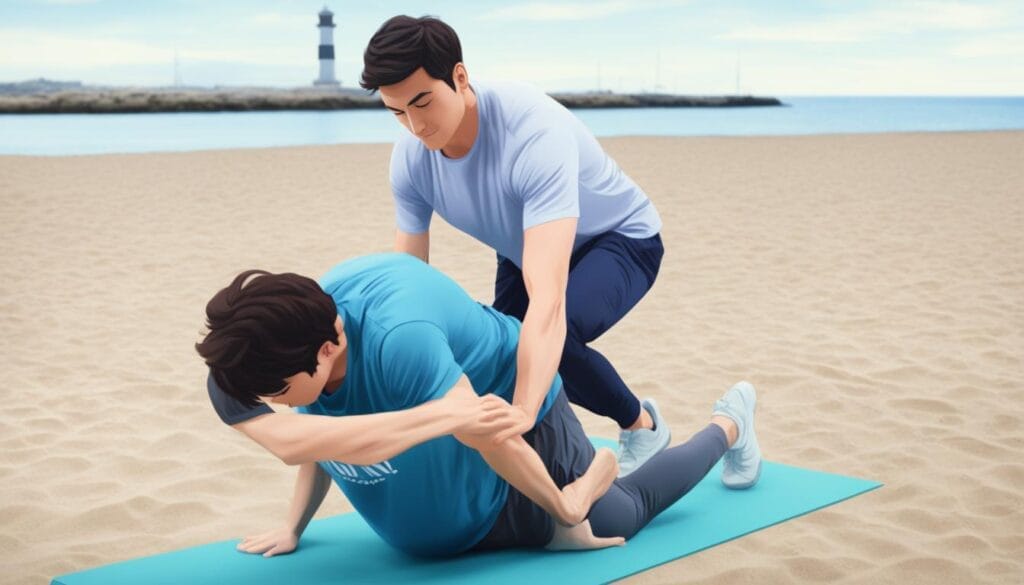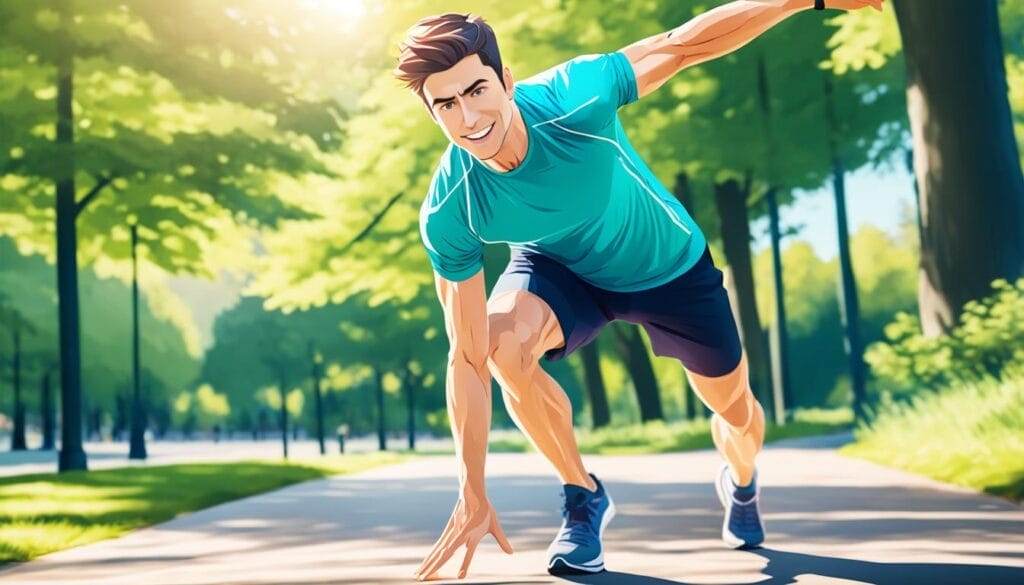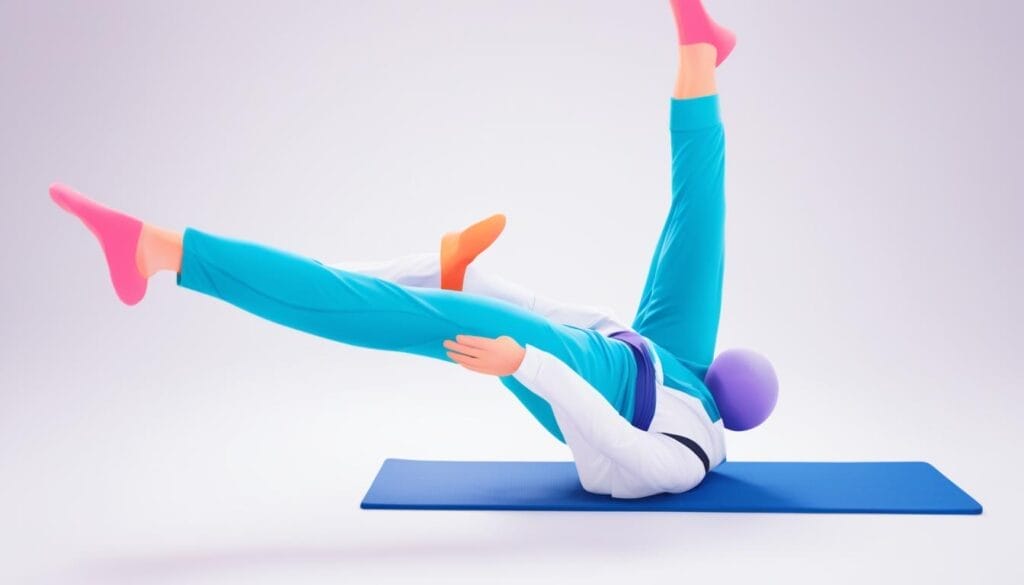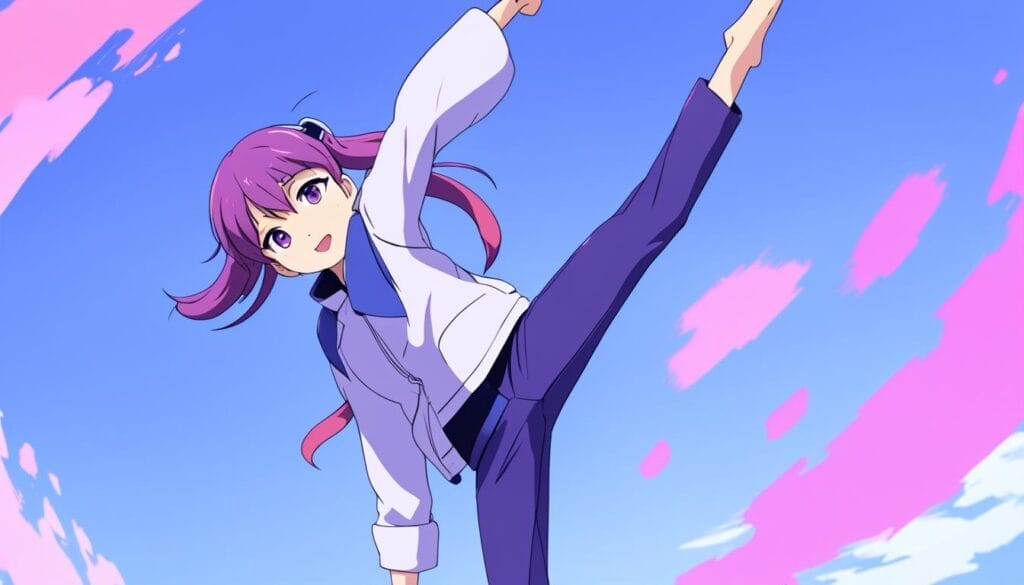Have you watched a skilled martial artist move gracefully? Their kicks fly through the air effortlessly. Their bodies twist into shapes that look impossible. I always wondered how they got so flexible and agile.
My martial arts journey began with wanting to be like those impressive fighters. I admired how they merged power with grace. It was clear that being flexible would help me reach my potential in martial arts.
I decided to start a special training plan to boost my flexibility for martial arts. I trained in Taekwondo and quickly learned that being flexible is about more than cool kicks. It helps your performance, stops injuries, and keeps you healthy.
Stretching regularly helped me move more freely. It made me notice my body’s abilities and limits. I found out that flexibility improves not just my body, but also my mind’s focus.
Flexibility is vital for martial arts success. It makes techniques easier and cuts the risk of getting hurt. It boosts your body sense, coordination, and balance. Flexibility is the key to mastering martial arts skills.
Key Takeaways:
- Flexibility is crucial for success in martial arts, contributing to enhanced performance, injury prevention, and overall well-being.
- Regular stretching exercises expand the range of motion in joints and muscles, allowing for efficient execution of techniques and reducing the risk of strain or injury.
- Flexibility improves body awareness, coordination, and balance, leading to improved martial arts skills.
- Flexibility is not just physical but also enhances mental focus and concentration.
- By incorporating a dedicated training regime and flexibility exercises, martial artists can unlock their full potential.
The Importance of Flexibility for Martial Arts
Being flexible is key in martial arts. It helps us do moves with skill and grace. As a martial artist, I know how much being flexible boosts my ability.
Flexibility aids in speed, balance, and how well you move. A limber body means quicker and more precise moves. It’s a big advantage, helping fighters react fast in any fight.
It also stops injuries. Stretching makes muscles and tendons more flexible. This lowers the chance of getting hurt. It keeps joints and ligaments safe from overstretching, too.
“Flexibility is not just about stretching but about preparing the body for movement and ensuring longevity in martial arts practice.”
So, stretching should be part of every martial artist’s routine. Besides learning moves and getting strong, stretching is vital. It makes sure we perform at our best and stay fit for a long time.
Let’s show how flexibility training changes things:
| Without Flexibility Training | With Flexibility Training |
|---|---|
| Reduced range of motion in techniques | Enhanced range of motion for powerful execution |
| Increased risk of strains and sprains | Decreased risk of strains and sprains |
| Less fluid and precise movements | Improved fluidity and precision |
The picture above shows why flexibility matters in martial arts. A flexible fighter can do strong moves easily. But, low flexibility means their actions might not be smooth or exact.
So, being flexible is vital in martial arts. It makes us better at what we do. With regular stretching, we can reach high levels in our sport without getting hurt.
Dynamic Stretching for Martial Arts
Dynamic stretching is vital for any martial arts warm-up. It involves moving body parts widely, just like in martial arts. This warms up your body, making you more flexible and mobile. It also gets your muscles ready for action, boosting your martial arts performance.
This type of stretching makes your muscles ready for action. It increases blood flow and oxygen to your muscles. Dynamic stretching also makes your muscles and joints limber. This lowers the chance of getting hurt during hard training or fights. It makes you more agile, quick, and flexible for martial arts moves.
Here are some exercises every martial artist should do:
- Begin with leg swings. Use a wall to balance. Swing your leg forward and back, gently increasing the movement. Then, switch to the other leg.
- Next is arm circles. Stretch your arms out to the sides and circle them both ways. Start small and make the circles bigger slowly.
- Finish with trunk rotations. Place your feet apart and twist your upper body from side to side, keeping your hips still.
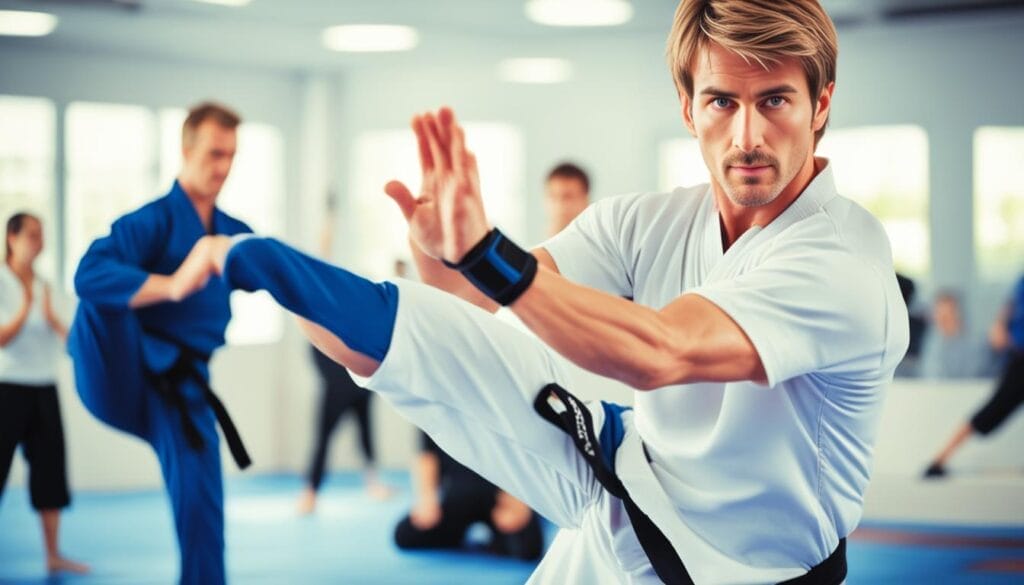
Always remember to do dynamic stretches with care and focus. Watch your posture and keep your breathing steady. Start slowly, then pick up the pace as your muscles get warm.
“Dynamic stretching before martial arts training can help improve your overall performance and reduce the risk of injuries.”
Adding dynamic stretches before you train in martial arts is great. It gets your body ready for the hard work ahead. This makes you perform better and stay safe. So you can keep training and reach your goals in martial arts.
Flexibility Drills for Martial Arts
Flexibility drills are key for getting better at martial arts. These drills work on the muscle groups you use a lot. Adding these into your training will boost your performance over time.
These drills involve stretches that aim at important muscles. They help improve how much you can move. This lets you do your moves more smoothly and accurately. You might do exercises like high kicks or splits.
The high kick exercise is a great one to try. It boosts your hamstrings, hips, and adductors (inner thigh). Stand by something sturdy for support, then kick your leg up high. Keep your form good and repeat on both sides.
Trying splits can also help a lot. This is good for your hamstrings, hips, and groin. Sit with your legs in a V-shape. Lean towards the center while keeping your muscles tight. As you get better, you can stretch more.
Deep lunges are another good drill. They stretch your hips, front thighs, and bottom. Take a big step forward into a lunge. Hold it and feel your muscles stretch. Do it on both sides for balance.
Keep doing these drills regularly. They will make a big difference. Listen to your body and increase your effort slowly over time.
Benefits of Flexibility Drills
– Improved range of motion for executing techniques with precision.
– Enhanced fluidity of movements, promoting grace and agility.
– Reduced risk of strains and injuries by increasing muscle elasticity.
– More extended muscles enabling greater flexibility and overall athletic performance.
| Flexibility Drill | Target Muscles | Instructions |
|---|---|---|
| High Kick Exercise | Hamstrings, Hip Flexors, Adductors | Stand facing a sturdy support, lift your leg as high as possible and hold the position for a few seconds. Repeat on both legs. |
| Split Exercise | Hamstrings, Hips, Groin | Sit on the floor with your legs spread apart, slowly lower your body towards the center and hold the stretch for a few seconds. |
| Deep Lunges | Hip Flexors, Quadriceps, Gluteal Muscles | Take a large step forward into a lunge position, hold the stretch for a few seconds. Repeat on the other side. |
Stretching Routine for Martial Arts
A stretching routine helps martial artists in their training. It includes both static and dynamic stretches. These exercises target key muscle groups, making you flexible and less likely to get hurt.
Static Stretches
Static stretches are about holding poses to stretch the muscles. They last 20-30 seconds and tackle muscles like hamstrings and shoulders. Adding these to your routine will make your muscles stretchier and increase movement.
Tip: Add static stretches to your plan. Hold for 20-30 seconds, breathe deep, and feel the stretch gently.
Dynamic Stretches
Dynamic stretches are active and get your body ready for martial arts moves. They help warm up, increase blood flow, and make your joints more flexible. Things like leg swings and lunges prepare your body well.
Sample Stretching Routine
This is a sample routine to do before and after your training:
- Start with an easy warm-up to get your heart pumping.
- Then do dynamic stretches like leg swings and arm circles to prepare your muscles.
- Next, do static stretches for 20-30 seconds on muscles like the hamstrings.
- Do more dynamic stretches to get fully ready for your martial arts practice.
- End your session with static stretches again to cool down and maintain flexibility.
Following this stretching plan can boost your flexibility and performance, while keeping you safe from injuries.
Flexibility for martial arts takes time and effort to build. Always push yourself gently and listen to your body. Also, check with your instructor to make sure you’re doing the right stretches for your martial arts type.
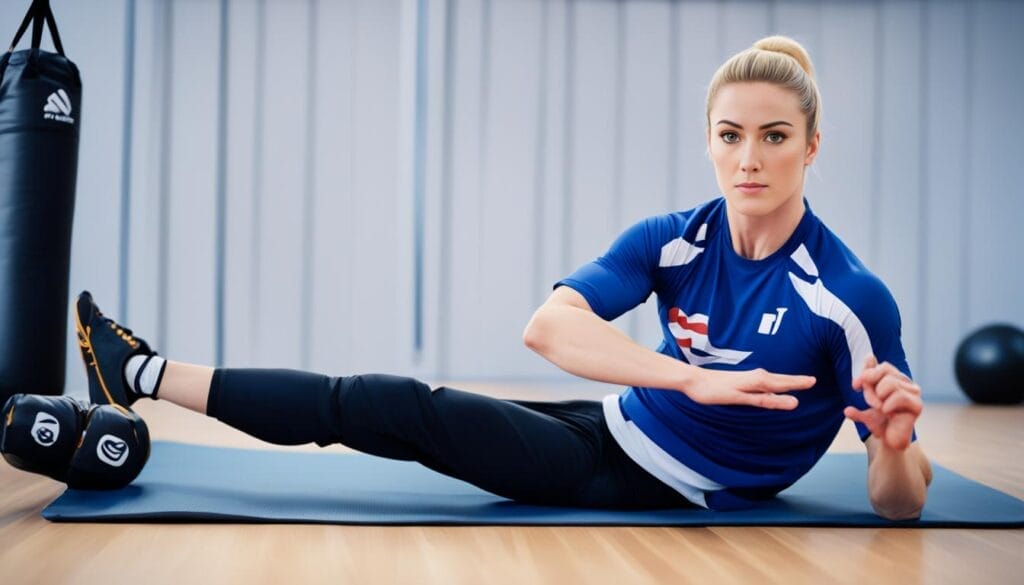
| Benefits of a Stretching Routine for Martial Arts: |
|---|
| Improves flexibility |
| Enhances performance |
| Reduces risk of injuries |
| Increases range of motion |
| Improves muscle elasticity |
Tips for Improving Flexibility for Martial Arts
Consistency is vital for boosting your flexibility in martial arts. Regular stretch exercises should be part of your training schedule. Focus on both static and dynamic stretches that work the main muscle groups for your art. As you go, make your stretches harder and last longer.
Adding yoga or Pilates to your routine can boost your flexibility and make you stronger.
Flexibility matters a lot in martial arts, and doing stretches often is key. By sticking to a routine of stretching, you can get much better and perform better. Aim for both static and dynamic stretches that target the key muscles you need.
Hold the first kind, static stretches, for a long time to let your muscles really stretch out. This includes moves like stretching your hamstrings or doing quad stretches. For each stretch, do them for 15-30 seconds and repeat a few times.
Dynamic stretches, meanwhile, are movements that warm up muscles and get the blood flowing. They get your body ready for martial arts moves. Think of leg swings and arm circles. Do these for 10-12 reps on each side. As you get better, make your dynamic stretches harder and longer.
Don’t forget yoga or Pilates in your training. They’re great for flexibility and making your body strong in important ways. Joining classes or adding their moves to your routine really helps.
“By consistently incorporating stretching exercises into my training routine, I have noticed significant improvements in my flexibility and overall performance in martial arts.”
Getting more flexible takes time and a lot of patience. Stick to a regular stretching plan and look for ways to stretch even further. With time and effort, you will make big strides in your martial arts flexibility.
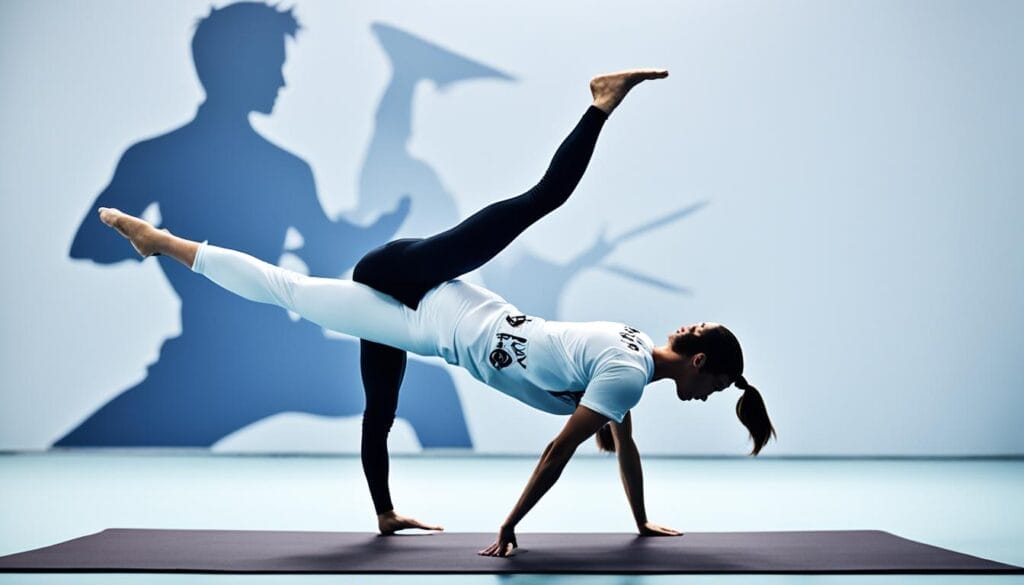
Summing Up
Being flexible is key in martial arts. Athletes should focus on exercises that improve their body’s flexibility. This reduces the chance of getting hurt. Consistent stretching helps martial artists reach their goals and stay safe.
FAQ
Why is flexibility important in martial arts?
Being flexible in martial arts is key. It lets you move smoothly and quickly when doing moves. It also boosts your balance, coordination, speed, and stops injuries.
What is dynamic stretching and why is it beneficial for martial arts?
Dynamic stretching warms up muscles by moving them widely. This type of stretching is great for martial arts. It gets your body ready for martial arts moves and makes you more flexible.
What are flexibility drills and how can they benefit martial arts?
Flexibility drills are exercises that aim to make certain muscles more flexible for martial arts. Doing these drills while training helps martial artists become more flexible. This boosts their performance.
What should a stretching routine for martial arts include?
A good martial arts stretching routine mixes static and dynamic stretches. It focuses on the main muscle groups used in martial arts. These stretches should be done before and after practice to prevent injuries and improve flexibility.
How can I improve flexibility for martial arts?
To get more flexible for martial arts, be consistent with your training. Do both static and dynamic stretches. Include yoga or Pilates to gain extra flexibility and strength.
Source Links
Share Me:
READY TO UNLEASH
YOUR BEST SELF?
Click “Sign Me Up!” And Start Your Fitness Transformation!


